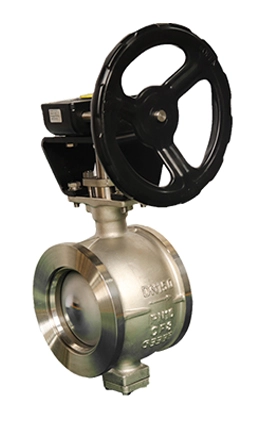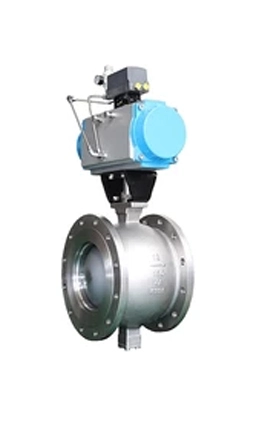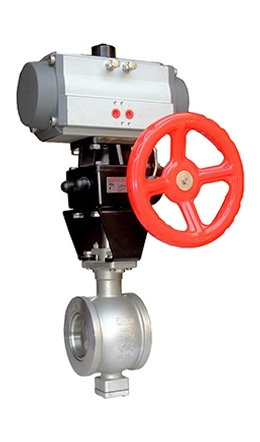Segment ball valves, alternatively referred to as V-port ball valves or partial ball valves, utilize a specially designed ball with a V-shaped notch or segmented profile rather than a standard full-bore opening. This unique structure enhances their ability to provide precise flow regulation and throttling, while still maintaining key advantages of conventional ball valves.



Segment ball valves, also known as V-port ball valves or partial ball valves, feature a ball with a V-shaped notch or segmented profile instead of a full bore. This design optimizes them for precise flow control and throttling, while retaining some benefits of traditional ball valves. Below are their key performance characteristics:
1. Flow Control and Throttling
Precise Modulation: The V-shaped notch allows linear or equal-percentage flow characteristics, enabling accurate control of flow rates.
Adjustable Cv (Flow Coefficient): The angle of the V-port (e.g., 15°, 30°, 60°, 90°) determines flow capacity, making them ideal for processes requiring variable flow control.
High Rangeability: Effective across a wide flow range (typically 100:1), outperforming standard ball valves.
2. Pressure Drop and Flow Efficiency
Controlled Pressure Drop: The V-port reduces turbulence and cavitation compared to standard ball valves, but pressure drop is higher than full-bore designs.
Directional Flow Optimization: Best suited for unidirectional flow (flow direction aligned with the V-port opening).
3. Shut-Off Capability
Bubble-Tight Shut-Off: Metal or soft seats (e.g., PTFE, reinforced polymers) provide ANSI Class IV to VI leakage standards.
Bidirectional Sealing: Some designs allow sealing against pressure from both directions.
4. Durability and Wear Resistance
Abrasion Resistance: Hardened materials (e.g., stellite-coated balls, metal seats) handle abrasive fluids (slurries, powders).
High-Pressure Tolerance: Suitable for Class 150–600 (up to 1,000+ psi), depending on materials and design.
Temperature Range:
Standard Seats: -20°C to 200°C (PTFE).
Metal Seats: -196°C (cryogenic) to 550°C.
5. Material Compatibility
Body Materials: Carbon steel, stainless steel (304/316), duplex steel, or exotic alloys (Hastelloy, Inconel) for corrosive fluids.
Seat Materials:
Soft Seats: PTFE, PEEK, or TFM for tight shut-off and low temperatures.
Metal Seats: Stainless steel, tungsten carbide for high temperatures/abrasion.
6. Applications
Process Industries: Throttling steam, chemicals, or gases in refining, petrochemical, and pharmaceutical systems.
Slurry Handling: Mining, wastewater treatment, and pulp/paper industries.
HVAC and Energy: Precise control of hot water, chilled water, or thermal oil.
Fire-Safe Systems: Metal-seated valves for API 607/6FA compliance in oil and gas.
The sealing surface treatment of a segment ball valve (also known as a V-port ball valve) is critical to ensure leak-tight performance, durability, and resistance to wear, corrosion, and erosion. The valve’s segment (partial ball) and seat surfaces undergo specialized treatments to enhance their functionality in demanding applications.
1. Hard Coating (Surface Hardening)
Purpose: Increases hardness and wear resistance for abrasive or high-pressure fluids.
Methods: Chromium Carbide (CrC) or Tungsten Carbide (WC) Coatings: Applied via thermal spray (HVOF) or PVD/CVD processes.
Stellite (Cobalt-Chromium Alloy): Welded or laser-cladded onto surfaces for extreme wear and temperature resistance (up to 800°C).
Electroless Nickel Plating (ENP): Provides uniform corrosion resistance and moderate hardness.
2. Polishing
Mirror Finish: The ball and seat surfaces are polished to a roughness of Ra ≤ 0.4 μm (micro-meters) to ensure smooth contact and minimize friction.
Benefits: Reduces sticking, improves sealing, and prevents particle buildup in slurry or viscous media.
3. Heat Treatment
Case Hardening: Processes like nitriding or carburizing create a hardened outer layer while retaining core toughness.
Tempering: Reduces brittleness after hardening.
4. Soft Sealing Overlays
Elastomer or Polymer Coatings:
PTFE (Teflon): Applied to metal seats for chemical resistance and low friction.
PEEK (Polyether Ether Ketone): High-temperature thermoplastic for aggressive media.
